Seafood Sustainability Supply Chain Trends and Challenges in Japan: Marine Stewardship Council Fisheries and Chain of Custody Certificates
Abstract
1. Introduction
2. Literature Review
3. Fish Stock Decline and the Definition of Sustainable Seafood
4. Materials and Methods
4.1. Questionnaire Survey for Producers
4.2. Questionnaire Survey for Distributors
5. Results
5.1. Producer Attitudes and Trends
5.1.1. Motivations and Difficulties in Obtaining Certification
5.1.2. Effects of Holding Certification and Influences of International Official Events
5.2. Distributor Attitudes and Trends
5.2.1. Respondents and Their Industries
5.2.2. Motivations for, and Difficulties in, Obtaining Certification, and Impact of Social Conditions
5.2.3. Actual Sales of Sustainable Seafood
5.2.4. Effects of Certification, Communication, and Future Challenges
6. Discussion
6.1. Further Adopting Sustainability in the Supply Chain in Japan
6.2. Next Steps for Promoting Sustainable Seafood in Japan
7. Conclusions
Author Contributions
Funding
Acknowledgments
Conflicts of Interest
Appendix A
- What is the purpose of your challenge to obtain MSC certification? Please check all that apply from the following. Please indicate any others. (Multiple answers allowed)
- 2.
- Why did you choose MSC certification over other certifications? Please check all that apply. Please indicate any other reasons. (Multiple answers allowed)
- 3.
- What difficulties did you encounter in obtaining certification? Please check all that apply. (Multiple answers are possible.) Please list any others.
- 4.
- Was there a difference in the reaction from consumers before and after certification? Please select the appropriate answer.
- 5.
- Did you notice any difference in reactions from suppliers, retailers, restaurants, etc. before and after certification? Please select the appropriate answer.
- 6.
- Did the Tokyo 2020 Olympic and Paralympic Games trigger the acquisition of certification? Please select the appropriate answer.
- 7.
- Did the social impact of the SDGs trigger your decision to obtain certification? Please select the appropriate answer.
- 8.
- What are your positive and negative aspects of the certification?
- 9.
- What do you think are the challenges for MSC certification in the future?
Appendix B
- What is the purpose of your challenge to obtain CoC certification? Please check all that apply. Please indicate any others. (Multiple answers allowed)
- 2.
- Why did you choose MSC/ASC Chain of Custody certification over other certifica- tions? Please check all that apply. Please indicate any other reasons. (Multiple answers are acceptable.)
- 3.
- What difficulties did you encounter in obtaining certification? Please check all that apply. Please indicate any others. (Multiple answers allowed)
- 4.
- Was there a difference in the reaction from consumers before and after certification? Please check all that apply.
- 5.
- Was there any difference in the reaction from suppliers, retailers, restaurants, etc.
- 6.
- Did the Tokyo 2020 Olympic and Paralympic Games trigger your certification? Please check all that apply.
- 7.
- Did the social impact of the SDGs trigger your decision to obtain certification? Please check all that apply.
- 8.
- What are your positive and negative aspects of the certification?
- 9.
- What do you think are the challenges for CoC certification in the future?
- 10.
- What media do you use to communicate to consumers about your CoC-certification? Please check all that apply. Please indicate any others. (Multiple answers allowed)
- 11.
- What else do you do to reach out to consumers regarding CoC-certified products? Please check all that apply. Please indicate any others (multiple answers allowed).
- 12.
- We would like to ask you about the status of sales of certified products. Do you always sell certified products? If so, how many species do you sell?
- 13.
- How do the purchase prices of certified products compare to similar products that are not certified?
- 14.
- How does the selling price of certified products compare to similar products that are not certified?
- 15.
- What do you expect from consumers? Please check all that apply. Please indicate any others. (Multiple answers allowed)
- 16.
- Have you received any reactions from consumers regarding certification?
- 17.
- If you chose "Yes very much" or "Yes" in 16, what kind of reaction have you received from consumers? (Free description)
- 18.
- In addition to fishery certification, there are other indicators and systems that indi cate the sustainability of fishery resources. Are you aware of any of the following programs? Please check all that you know. Please indicate any others you are aware of. (Multiple answers allowed)
- 19.
- Do you know that Blue Seafood Guide also introduces MSC/ASC certification?
- 20.
- Do you feel that consumers in general are becoming more aware of sustainability and environmental considerations?
- 21.
- What do you expect the government to do to encourage consumers to choose sus tainable seafood products? (Multiple answers allowed)
- 22.
- What do you think is needed to encourage consumers to choose sustainable seafood? (Free answer)
References
- Martindale, W.; Lucas, K. Global Resource Flows in the Food System. In Environment and Climate-Smart Food Production; Galanakis, C.M., Ed.; Springer: Cham, Switzerland, 2022; pp. 219–257. [Google Scholar]
- Bleshi, J.; Hoey, L.; Jones, A.D.; Friedmann, H.; Perfecto, I. Development pathways toward “zero hunger”. World Dev. 2019, 118, 1–14. [Google Scholar] [CrossRef]
- Ishangulyyev, R.; Kim, S.; Lee, S.H. Understanding food loss and waste—Why are we losing and wasting food? Foods 2019, 8, 297. [Google Scholar] [CrossRef] [PubMed]
- Yagi, N. Fishery Reformation and the Future of Seafood Consumption; Koseisha Koseikaku: Tokyo, Japan, 2020. (In Japanese) [Google Scholar]
- Makino, M. Fisheries Management in Japan: Its Institutional Feature and Case Studies; Springer: Berlin/Heidelberg, Germany, 2011. [Google Scholar]
- Marine Stewardship Council Press Release. The Number of MSC CoC-Certified Businesses in Japan that Handle MSC-Certified Marine Products has Exceeded 300. Available online: https://www.msc.org/jp/what-you-can-do/media-centre/press-releases/210125 (accessed on 17 August 2022). (In Japanese).
- Marine Stewardship Council. MSC Newsletter. January 2021. Available online: https://www.msc.org/docs/default-source/jp-files/newsletter/mscjapan_newsletter_202101.pdf (accessed on 17 August 2022). (In Japanese).
- Aquaculture Stewardship Council. “Find a Farm”. Available online: https://www.asc-aqua.org/find-a-farm/ (accessed on 29 April 2022).
- MEL. List of Certified Businesses and Organizations. Available online: https://www.melj.jp/list (accessed on 28 April 2022).
- Iue, M.; Makino, M.; Asari, M. The development of “Blue Seafood Guide,” a sustainable seafood rating program, and its implication in Japan. Mar. Policy 2022, 137, 104945. [Google Scholar] [CrossRef]
- Parsons, K.; Lang, T.; Barling, D. London’s food policy: Leveraging the policy sub-system, programme and plan. Food Policy 2021, 103, 102037. [Google Scholar] [CrossRef]
- Seafood Legacy. Sustainable Reform of the Fisheries Industry in Light of the London Olympics. Available online: https://times.seafoodlegacy.com/archives/821 (accessed on 19 August 2022). (In Japanese).
- Ministry of Foreign Affairs of Japan. Spouse Program at the 8th Pacific Island Summit in Fukushima. Available online: https://www.mofa.go.jp/mofaj/a_o/ocn/page4_004027.html (accessed on 28 April 2022). (In Japanese)
- Ministry of Foreign Affairs of Japan. Spouse Program at G20 Osaka Summit. Available online: https://www.mofa.go.jp/mofaj/gaiko/g20/osaka19/jp/topics/partner_02.html (accessed on 28 April 2022). (In Japanese)
- Ministry of Foreign Affairs of Japan. Activities of the First Lady Akie Abe during Prime Minister Abe’s Attendance at the 74th United Nations General Assembly. Available online: https://www.mofa.go.jp/mofaj/fp/unp_a/page3_002893.html (accessed on 28 April 2022). (In Japanese)
- Kiminami, L.; Furusawa, S.; Kuwabara, T. Factor Analysis of the Structure of Consumers’ Attitudes toward Seafood—Toward the Development of a Sustainable Seafood Food System. Agric. Econ. Soc. Jpn. Collect. Pap. 2013, 250–257. (In Japanese) [Google Scholar]
- Hori, J.; Wakamatsu, H.; Miyata, T.; Oozeki, Y. Has the consumers awareness of sustainable seafood been growing in Japan? Implications for promoting sustainable consumerism at the Tokyo 2020 Olympics and Paralympics. Mar. Policy 2020, 115, 103851. [Google Scholar] [CrossRef]
- Fisheries Agency. Changes in Fishery Management Structure. Available online: https://www.jfa.maff.go.jp/j/kikaku/wpaper/r01_h/trend/1/t1_f2_1.html (accessed on 18 August 2022). (In Japanese)
- Kawabe, M. The Potential of the Resource Management Certification System as a Regional Management Tool: A Case Study of ASC Certification for Oyster Farming in the Togura District of Minamisanriku Town. Jpn. Int. Fish. Res. Soc. 2019, 17, 83–97. (In Japanese) [Google Scholar]
- Uchida, H.; Onozaka, Y.; Morita, T.; Managi, S. Demand for ecolabeled seafood in the Japanese market: A conjoint analysis of the impact of information and interaction with other labels. Food Policy 2014, 44, 68–76. [Google Scholar] [CrossRef]
- Wakabayashi, Y. The value reproduction of the cultured red sea bream. J. Reg. Fish. Econ. 2011, 51, 1–20. [Google Scholar]
- FAJ. Fisheries White Paper for 2028 2. Fishery Products Consumption. Available online: https://www.jfa.maff.go.jp/j/kikaku/wpaper/r01_h/trend/1/t1_4_2.html (accessed on 8 June 2022). (In Japanese).
- Jussaume, J.R.A.; Hisano, S.; Taniguchi, Y. Food safety in modern Japan. Japanstudien 2001, 12, 211–228. [Google Scholar] [CrossRef]
- MAFF. Statics of Agriculture, Forestry and Fisheries. Available online: https://www.maff.go.jp/j/syouan/seisaku/trace/attach/pdf/index-111.pdf (accessed on 28 April 2022). (In Japanese).
- Japan Fisheries Association. A Survey on 1,000 Men and Women’s Tendency toward Meal, Cooking and Seafood Consumption. Available online: https://osakana.suisankai.or.jp/archive/278 (accessed on 8 June 2022). (In Japanese).
- Maruha Nichiro Corporation. Survey on Seafood Consumption 2020. Available online: https://www.maruha-nichiro.co.jp/corporate/news_center/research/016.html (accessed on 8 June 2022). (In Japanese).
- Uchida, H.; Roheim, C.A.; Wakamatsu, H.; Anderson, C.M. Do Japanese consumers care about sustainable fisheries? Evidence from an auction of ecolabel led seafood. Aust. J. Agric. Resour. Econ. 2013, 58, 263–280. [Google Scholar] [CrossRef]
- Hori, J.; Makino, M.; Ozeki, Y. An Examination of Factors Influencing Consumers’ Environmentally Conscious Purchasing Behavior for Marine Products. J. Coast. Zone Stud. 2020, 33, 53–64. [Google Scholar]
- Marine Stewardship Council Press release. Global Survey Reveals Shifts in Consumer Buying Attitudes Amid Growing Marine Environmental Concerns. Available online: https://www.msc.org/jp/what-you-can-do/media-centre/press-releases/220608 (accessed on 8 June 2022). (In Japanese).
- Togawa, T. Changeability of Consumer’s purchase decisions. A Construal Level Approach. Chikura Shobo 2019, 40, 113–115. (In Japanese) [Google Scholar]
- Swartz, W.; Schiller, L.; Sumaila, R.U.; Ota, Y. Searching for market-based sustainability pathways: Challenges and opportunities for seafood certification programs in Japan. Mar. Policy 2019, 76, 185–191. [Google Scholar] [CrossRef]
- Asche, F.; Bronnmann, J. Price premiums for ecolabelled seafood: MSC certification in Germany. Agric. Resour. Econ. 2017, 61, 576–589. [Google Scholar] [CrossRef]
- Wessells, C.R.; Johnston, R.J.; Donath, H. Assessing consumer preferences for ecolabeled seafood: The influence of species, certifier and household attributes. Am. J. Agric. Econ. 1999, 81, 1084–1089. [Google Scholar] [CrossRef]
- Brecard, D.; Hlaimi, B.; Lucas, S.; Perraudeau, Y.; Salladarre, F. Determinants of demand for green products: An application to eco-label demand for fish in Europe. Ecol. Al Econ. 2009, 69, 115–125. [Google Scholar] [CrossRef]
- Salladarre, F.; Guillotreau, P.; Perraudeau, Y.; Monfort, M. The demand for seafood eco-labels in France. J. Agric. Food Ind. Organ. 2010, 8, 1–26. [Google Scholar] [CrossRef]
- Gutierrez, A.; Thornton, T.F. Can consumers understand sustainability through seafood eco-labels? A US and UK case study. Sustainability 2014, 6, 8195–8217. [Google Scholar] [CrossRef]
- Barclay, K.; Miller, A. The sustainable seafood movement is a governance concert, with the audience playing a key role. Sustainability 2018, 10, 180. [Google Scholar] [CrossRef]
- Pauly, D. A vision for marine fisheries in a global blue economy. Mar. Policy. 2018, 87, 371–374. [Google Scholar] [CrossRef]
- Hilborn, R.; Fulton, E.A.; Green, B.S.; Hartmann, K.; Tracey, S.R.; Watson, R.A. When is a fishery sustainable? Can. J. Fish. Aquat. Sci. 2015, 72, 9. [Google Scholar] [CrossRef]
- Ostrom, E. A general framework for analyzing sustainability of social-ecological systems. Science 2009, 325, 419–422. [Google Scholar] [CrossRef] [PubMed]
- Perry, R.I.; Barange, M.; Ommer, R.E. Global changes in marine systems: A social-ecological approach. Prog. Oceanogr. 2010, 87, 331–337. [Google Scholar] [CrossRef]
- Food and Agriculture Organization of the United Nations (FAO). The State of World Fisheries and Aquaculture 2020. 2020. Available online: http://www.fao.org/state-of-fisheries-aquaculture (accessed on 6 August 2022).
- Bellchambers, L.M.; Fisher, E.A.; Harry, A.V.; Travaille, K.L. Identifying and mitigating potential risks for Marine Stewardship Council assessment and certification. Fish. Res. 2016, 182, 7–17. [Google Scholar] [CrossRef]
- Suzuki, M. MSC and Japanese fishery. Nippon Suisan Gakkaishi 2017, 83, 82. (In Japanese) [Google Scholar] [CrossRef]
- MAFF. Survey of Attitudes and Intentions Concerning Food, Agriculture, and Fisheries. Available online: https://www.maff.go.jp/j/finding/mind/attach/pdf/index-3.pdf (accessed on 28 April 2022). (In Japanese).
- MAFF. Survey of Attitudes and Intentions Concerning Food, Agriculture, and Fisheries. Available online: https://www.maff.go.jp/j/finding/mind/attach/pdf/index-19.pdf (accessed on 28 April 2022). (In Japanese).
- MAFF. Information on the Final Decision on Subsidies, etc. (Final). Available online: https://www.maff.go.jp/j/aid/kohu_kettei/r03/index.html (accessed on 28 April 2022). (In Japanese).
- Sakita, S. Local Diversity of Small-Scale Fisheries Management in Japan. Ph.D. Thesis, Nagoya University, Aichi, Japan, 25 March 2019. [Google Scholar]
- Marine Stewardship Council Press release. Preparatory Council for International Fishery Certification of Kochi and Miyazaki Inshore Single-Hook Bonito Fishery Obtains MSC Certification for Single-Hook Bonito and Albacore Tuna Fishery. Available online: https://www.msc.org/jp/what-you-can-do/media-centre/press-releases/210622 (accessed on 28 April 2022). (In Japanese).
- Seafood Legacy Times. Establish a world-class fishery for the next generation, to protect local livelihoods. Seafood Legacy. 16 November 2020. Available online: https://times.seafoodlegacy.com/archives/6308 (accessed on 28 April 2022). (In Japanese).
- Ganseforth, S. Olympic Leverages: The struggle for sustainable food standards. Japan through the lens of Tokyo Olympics. In Japan Through the Lens of the Tokyo Olympics; Routledge: London, UK, 2020; pp. 125–127. [Google Scholar]
- Asano, C. The issues of marine ecolabel consider from SDGs and fishery procurement of the Tokyo Olympic Games. Shohi Seikatsu Kenkyu 2018, 20, 41–48. (In Japanese) [Google Scholar]
- WWF Japan. Evaluation of the Fisheries Procurement Code and the “Sustainability-conscious Fisheries Procurement Code” as it should be. Available online: https://www.wwf.or.jp/activities/addinfo/4272.html (accessed on 12 June 2022). (In Japanese).
- Seafood Source Tokyo Olympics’ Sustainability Legacy Outweighs Actual Sales. Available online: Ttps://www.seafoodsource.com/news/environment-sustainability/tokyo-olympics-sustainability-legacy-outweighs-actual-sales (accessed on 28 April 2022). (In Japanese).
- Sustainability Post-Games Report. The Tokyo Organizing Committee of the Olympic and Paralympic Games. 2021. Available online: chrome-extension://efaidnbmnnnibpcajpcglclefindmkaj/https://www.2020games.metro.tokyo.lg.jp/68f51c6d690cd135211f54f5e41845d9.pdf (accessed on 24 September 2022). (In Japanese).
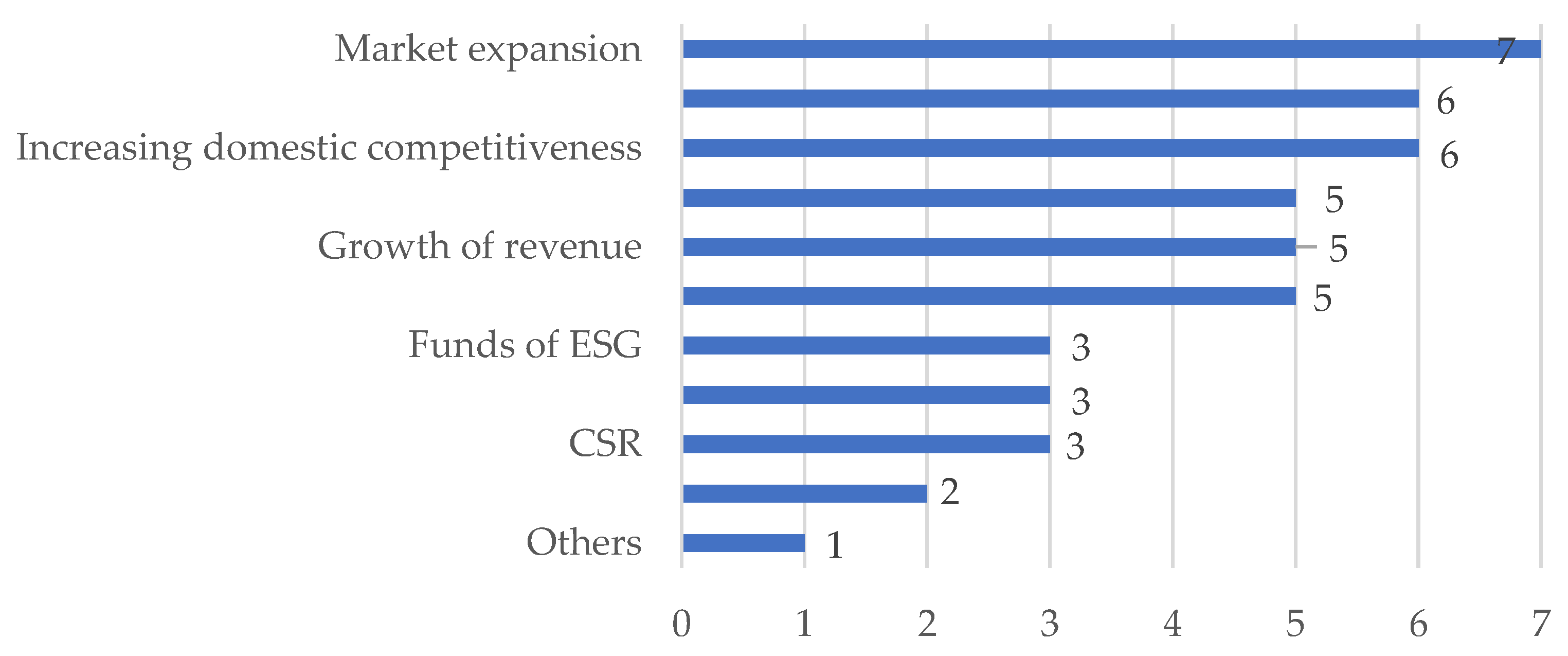
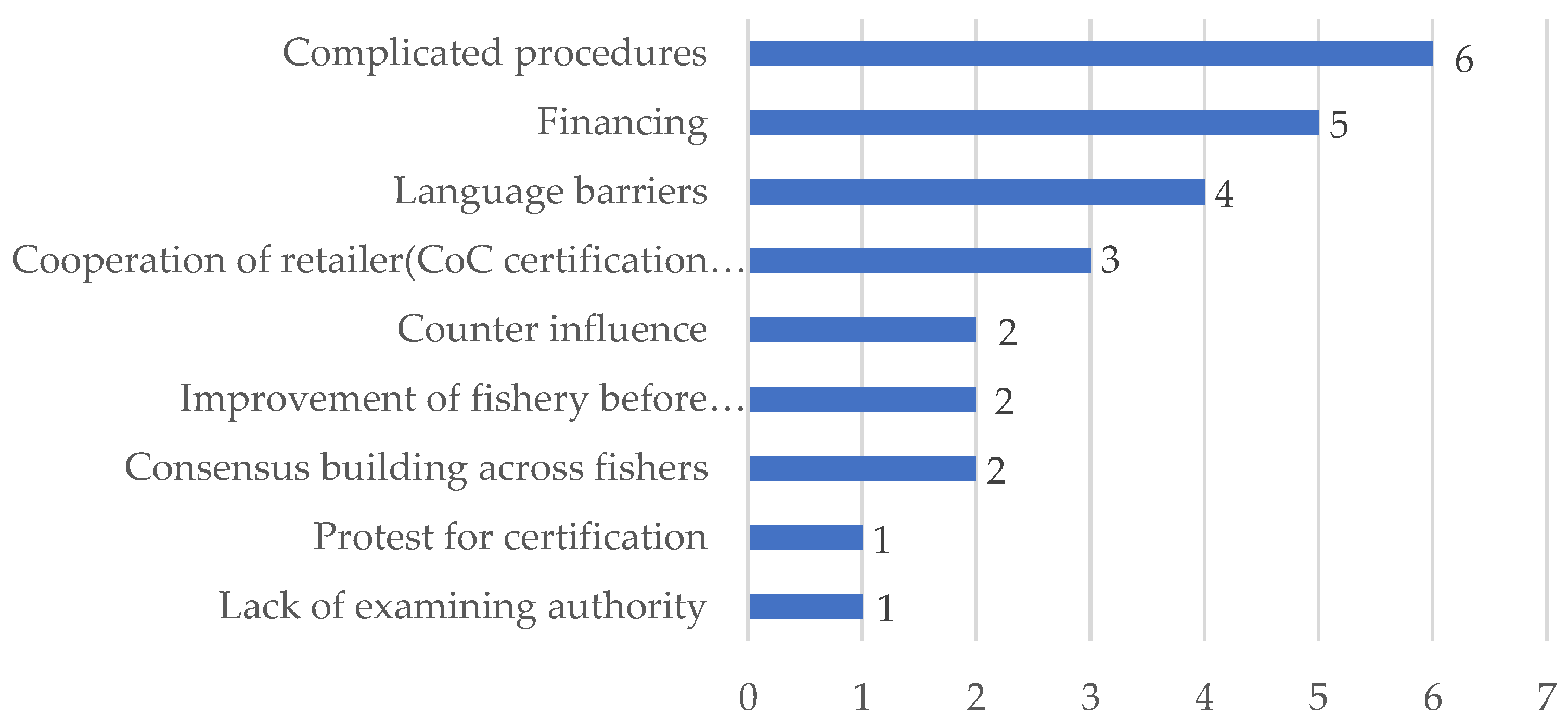
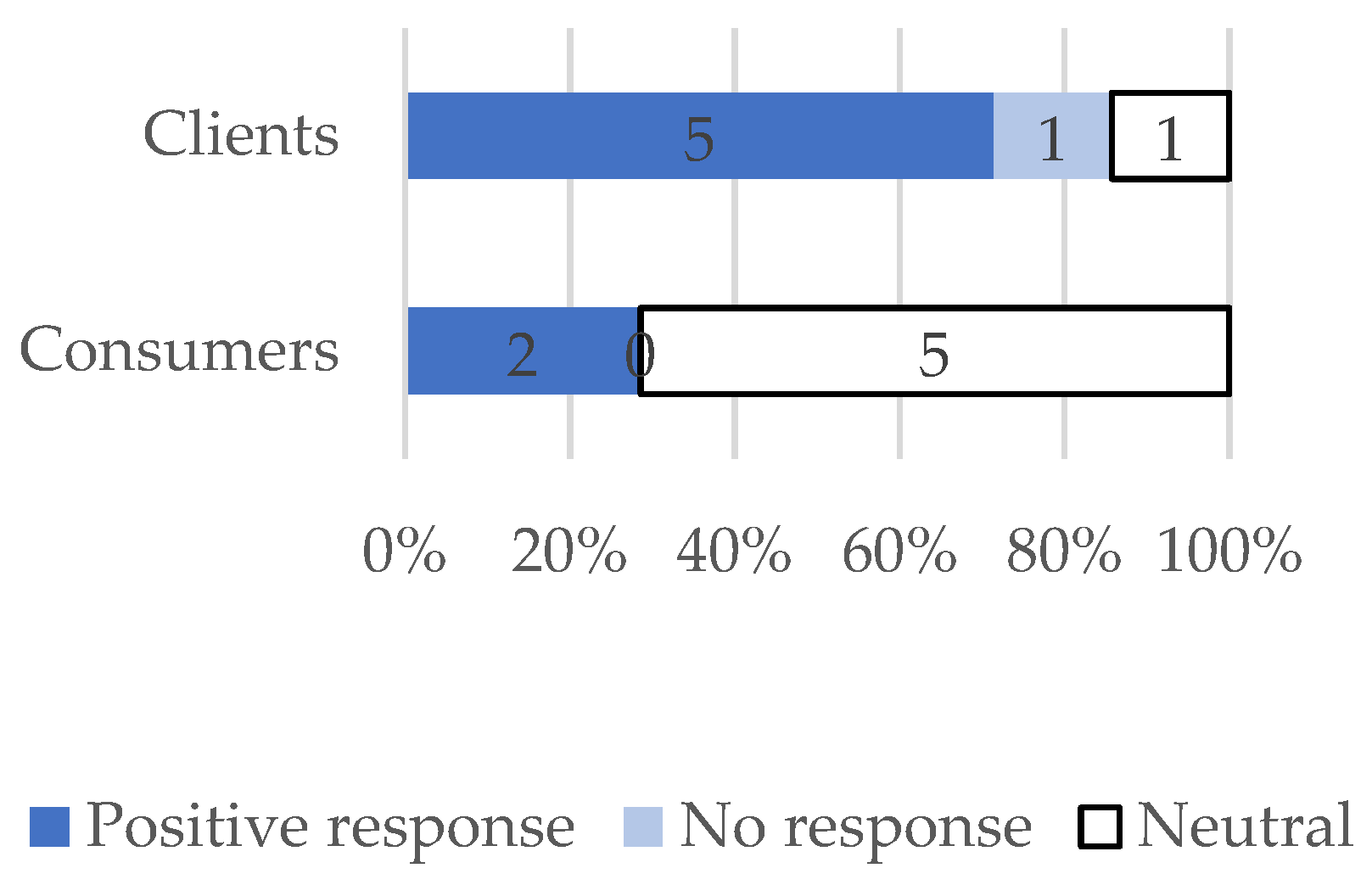

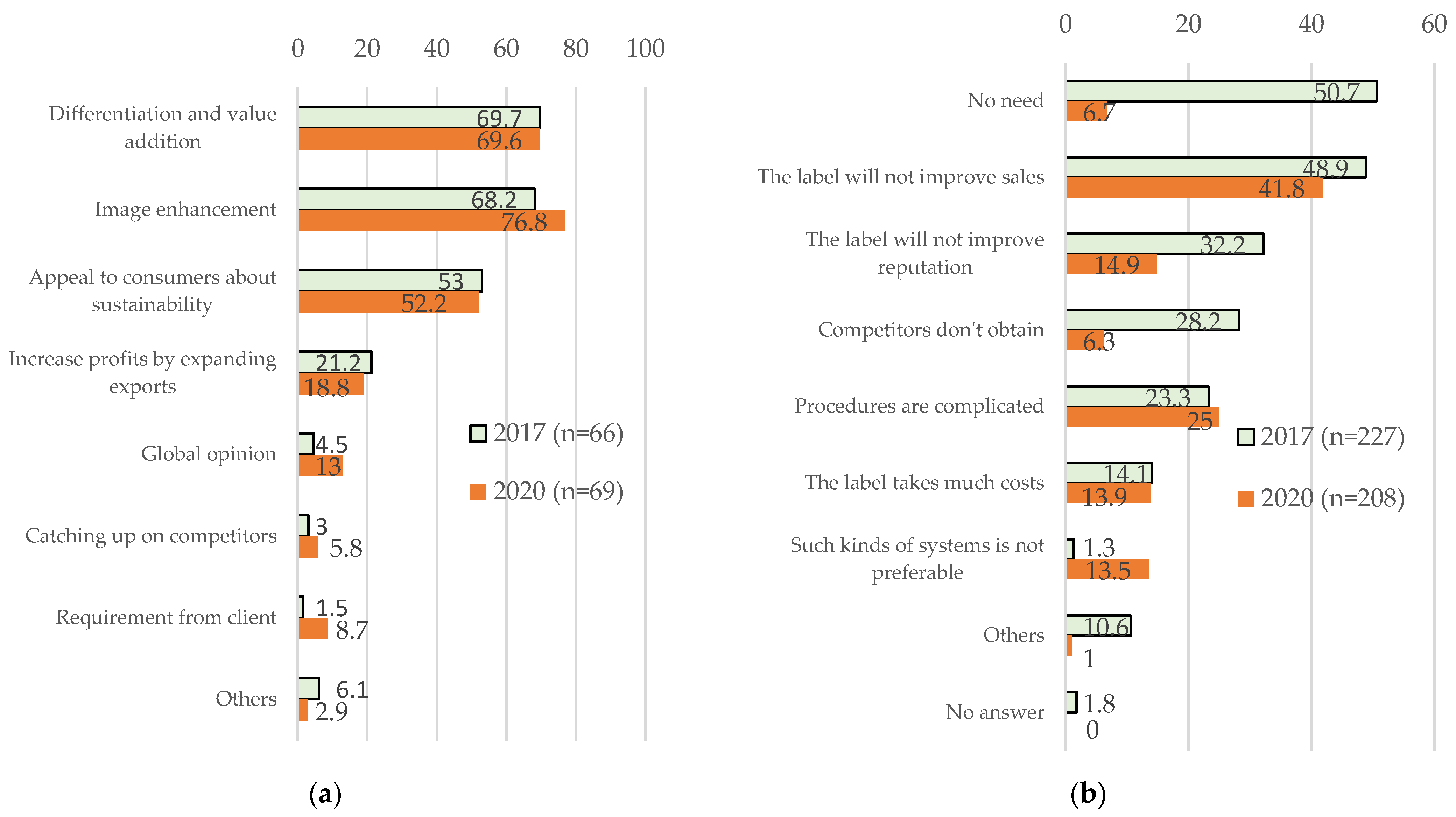
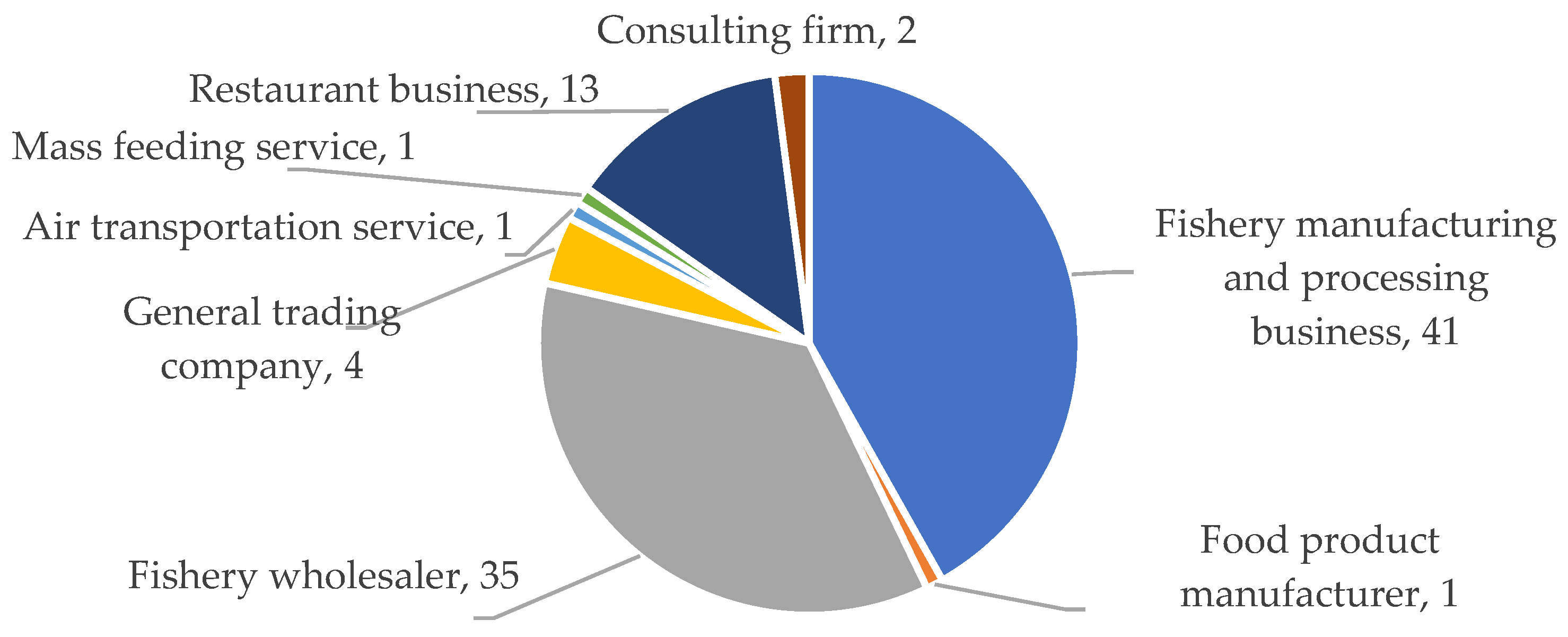

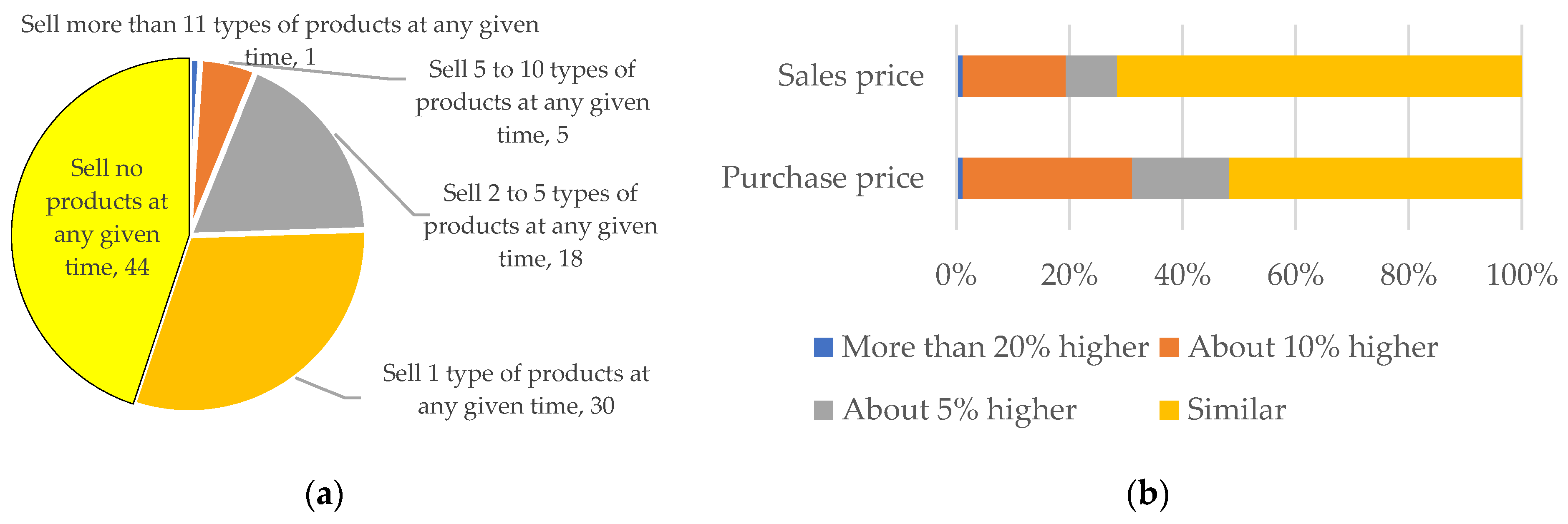

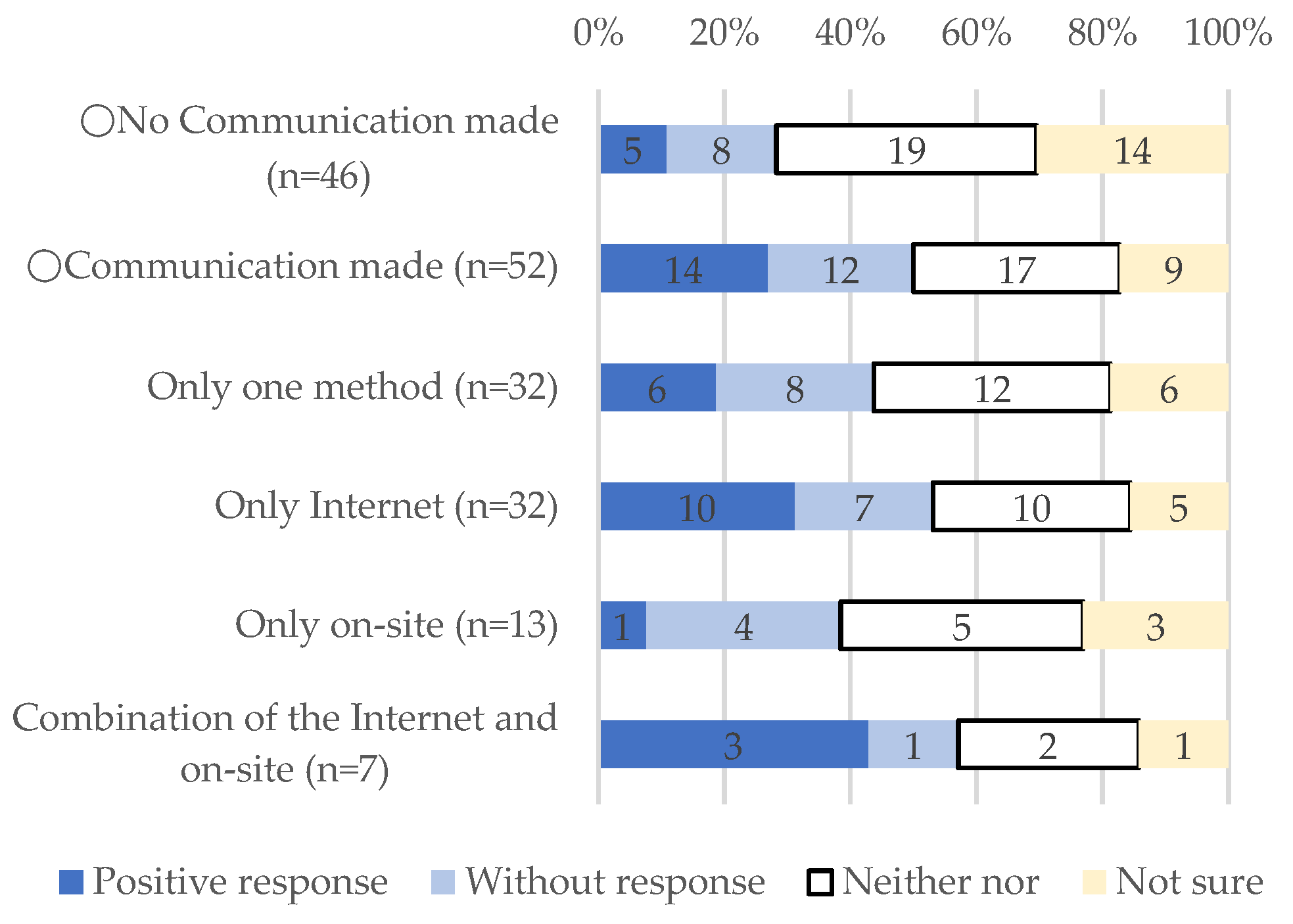
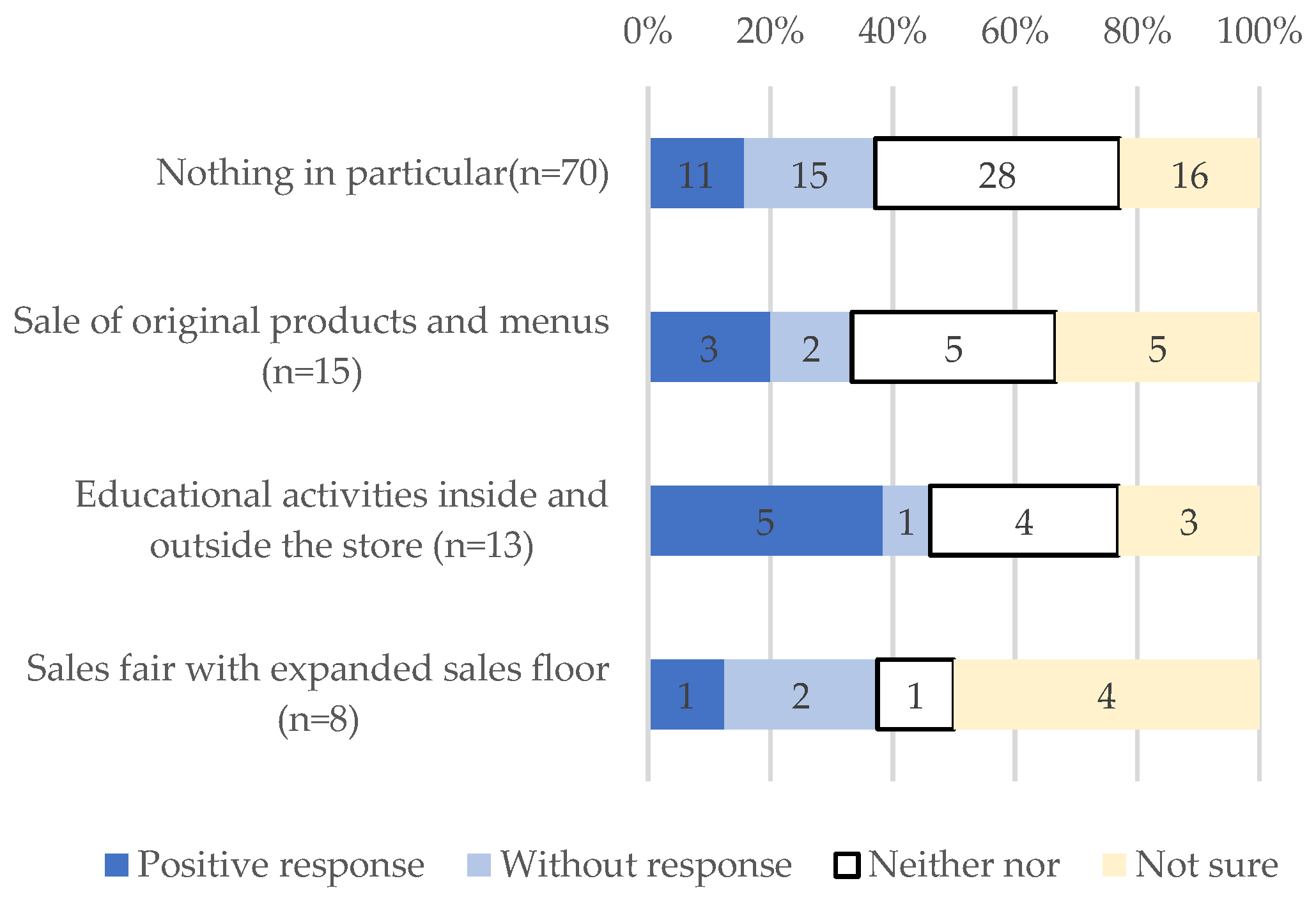

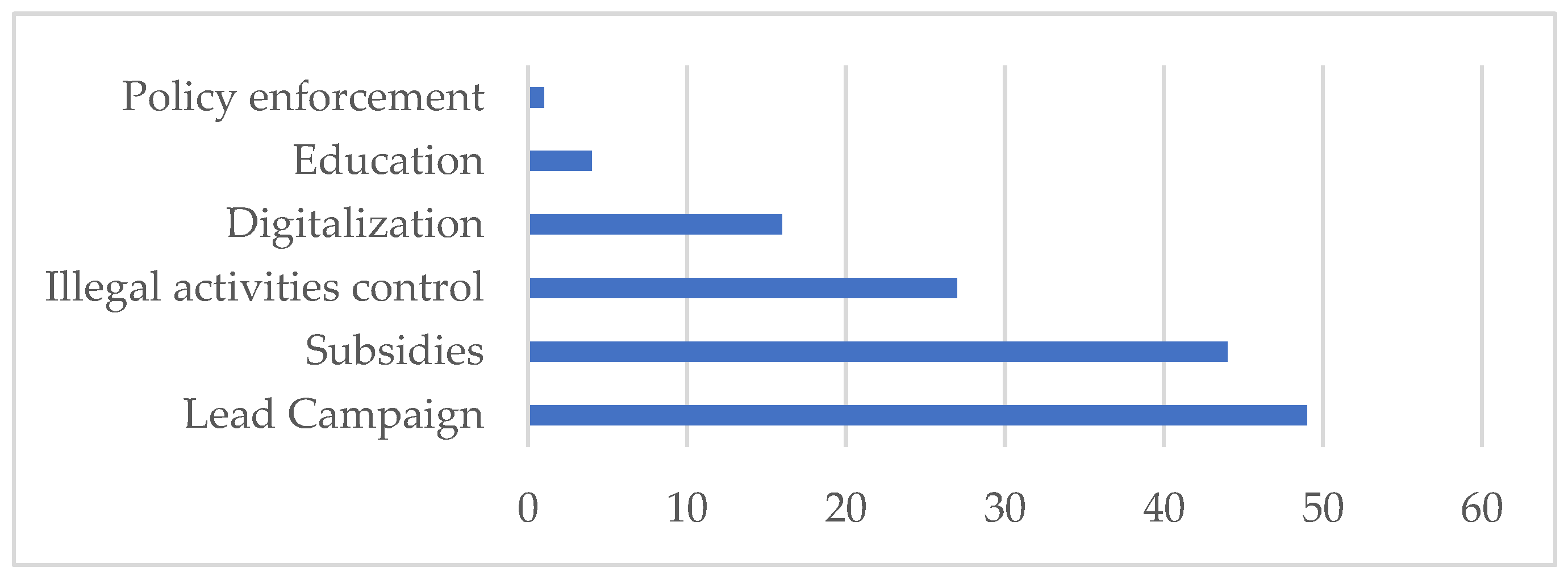

| Clarifications by the Previous Studies | Research Gaps |
|---|---|
| Previous studies for the motivation of seafood consumption: Strong preference for domestic and natural seafood. (Uchida et al., 2014 [20]) Prefer natural fish than farmed (Wakabayashi, 2011 [21]) Taste, price, freshness, safety, seasonality, nutrition, and health. Additionally, nutritional intake and season (FAJ 2022, [22]. JF, 2022 [25]) Raising awareness for seafood sustainability: Consumers are more willing to pay for sustainable seafood when informed of the global seafood crisis (Uchida et al., 2013 [27]) Acceptance of the importance of seafood sustainability has increased from 2017 to 2019, (Hori et al., 2020 [28]) Consumers respond to ecolabels only after receiving information on environmental issues, and that consumers show a general lack of awareness. (Uchida et al., 2013 [27]) The obstacles to seafood certification in Japan are due to a structural mismatch between the certification system and the Japanese domestic fisheries and seafood supply chain. (Swartz et al. 2019 [31]) A sample of European consumers revealed a tendency for well-educated young women to be the largest market for eco-labeled seafood. (Brécard et al. 2009 [34]) Seafood ecolabel markets are not driven by consumer demand but by the interactions of social movement, organizations, states, consumers, and companies. (Gutierrez and Thornton, 2014 [36]) An ecological focus alone does not guarantee long-term sustainability of any form, and that a socio-ecological perspective is essential to seafood sustainability if it is to be effective across cultures and in the future. (Hilborn et al., 2015 [39]) | Motivation and hurdles for obtaining MSC and CoC certificate in Japan. Perspective of supply chain. Mind of CoC holders. Differences in the level of awareness of proactive producers and distributors. Whether there is consistent, mutual distribution of sustainability information among the certified stakeholders. Whether the MSC and CoC certification is fully used, despite the additional effort and cost. Where the certificate holders find hurdles: internally and externally. |
| Communication | Number of Respondents | Percentage for All Respondents | Percentage for Respondents with Communication |
|---|---|---|---|
| Communication | 46 | 47% | |
| No communication | 52 | 53% | |
| Only one method | 31 | 32% | 60% |
| Only Internet | 31 | 32% | 60% |
| Only on-site | 13 | 13% | 25% |
| Combination of Internet and on-site | 8 | 8% | 15% |
| Promotions Made | Number of Respondents | % |
|---|---|---|
| Nothing in particular | 70 | 71% |
| Sale of original products and menus | 15 | 15% |
| Educational activities inside and outside store | 13 | 13% |
| Sales fair with expanded sales floor | 8 | 8% |
Publisher’s Note: MDPI stays neutral with regard to jurisdictional claims in published maps and institutional affiliations. |
© 2022 by the authors. Licensee MDPI, Basel, Switzerland. This article is an open access article distributed under the terms and conditions of the Creative Commons Attribution (CC BY) license (https://creativecommons.org/licenses/by/4.0/).
Share and Cite
Iue, M.; Makino, M.; Asari, M. Seafood Sustainability Supply Chain Trends and Challenges in Japan: Marine Stewardship Council Fisheries and Chain of Custody Certificates. Sustainability 2022, 14, 13523. https://doi.org/10.3390/su142013523
Iue M, Makino M, Asari M. Seafood Sustainability Supply Chain Trends and Challenges in Japan: Marine Stewardship Council Fisheries and Chain of Custody Certificates. Sustainability. 2022; 14(20):13523. https://doi.org/10.3390/su142013523
Chicago/Turabian StyleIue, Minako, Mitsutaku Makino, and Misuzu Asari. 2022. "Seafood Sustainability Supply Chain Trends and Challenges in Japan: Marine Stewardship Council Fisheries and Chain of Custody Certificates" Sustainability 14, no. 20: 13523. https://doi.org/10.3390/su142013523
APA StyleIue, M., Makino, M., & Asari, M. (2022). Seafood Sustainability Supply Chain Trends and Challenges in Japan: Marine Stewardship Council Fisheries and Chain of Custody Certificates. Sustainability, 14(20), 13523. https://doi.org/10.3390/su142013523






